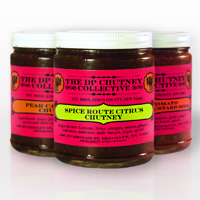As the saying goes, necessity is the mother of invention. That was the case when Atlanta native Drake Page couldn’t find the Southern-style chutneys of his childhood on the shelves of New York City grocery stores. Craving the sweet-and-sour tang of those jam-like condiments, Page took to the kitchen and created The D.P. Chutney Collective, a brand of small-batch, Southern-style chutneys made in Greenpoint, Brooklyn.
As this wet spring barrels toward summer, Page is gearing up to start turning the mountains of seasonal produce hitting farmers' markets into neat jars of spreadable sweetness.
Chutney lasts for about a month in the refrigerator and making it is a good way to use excess produce from Community Supported Agriculture (C.S.A.) deliveries and farmers markets.
Page (pictured below) explains that Southern-style chutneys differ from traditional South Asian ones in taste, consistency, and the types of produce used. Chutneys started turning up in the south at port cities along the East Coast. Over time, the chutneys have taken on characteristics that distinguish them from those found in India. 
“South Asian chutney could be really anything...in the consistency of a sauce,” says Page. “They’re often sour, salty, very spicy, whereas a Southern chutney...tends to be more in the form of almost preserves. It’s a thicker, sweeter condiment. It’s pretty much always sweet and sour with a degree of spice added to it."
Page adds that since the growing season in the Northeast is much shorter than that of the South, he has a smaller window of time to work within and a more narrow list of local produce to use.
Matt Lee, who wrote the cookbook Simple Fresh Southern with his brother Ted Lee, notes that Southern-style chutneys tend to be less spicy than their Indian counterparts. “They have vigorous flavor but not a lot of chili heat, or cayenne pepper or any kind of chili spice,” he says. “Southerners tend to like their spicy things to be on the mild side.” Lee, who grew up in Charleston, S.C., adds that pear chutneys are the most common in the South and that the condiment is often spread on a Ritz cracker with cheese.
Both Lee and Page also recommend using chutney as a spread on grilled cheese sandwiches and as an accompaniment to grilled meat. Page notes that as tastes begin to change, he’s been seeing an increasing popularity in serving chutney with cheese and charcuterie boards. Or, chutney is being thinned down with oil to make marinades and glazes.
"Anything that can be made into a chutney pretty much has been, I’m pretty sure, down South," says Page, who adds that he’s currently making rhubarb chutney since the vegetable is in season now.
Below, try Page’s recipe for Rhubarb and Apricot Chutney. He says this chutney is simple, quick and especially good with ham, roast chicken and sharp, aged Cheddar or dry Gouda cheeses.
Rhubarb and Apricot Chutney
- 4 cups sliced rhubarb

- 1 cup golden raisins
- 1 cup light brown sugar
- 1/2 cup chopped dried apricots
- 1/2 cup cider vinegar
- 1 small onion, finely chopped
- 1/4 cup crystallized ginger candy
- 1-2 tsp quality curry powder
- 1/2 tsp ground nutmeg
- 1/4 tsp kosher salt
Combine all the ingredients in a medium-sized stainless steel or enamel saucepan. Bring to a boil, then reduce to a simmer. Stir frequently for 10 to 15 minutes or until thick.
Cool and refrigerate. Under refrigeration, this chutney should last for about 30 days.